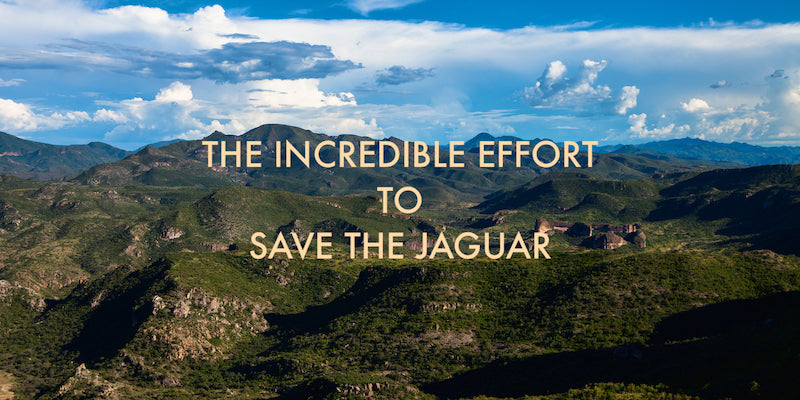The Incredible Effort to Save the Jaguar

The Jaguar is the largest big cat native to North America and the third largest cat in the world. It has played an important role in North and South American religion, mythology, and art due to its beautiful spotted coat, ferocity, strength, and elusiveness. But being revered and admired for millennia has not spared the jaguar from the effects of habitat loss, hunting, and conflicts with livestock. Northern jaguar numbers have dropped dramatically over the last 100 years, barely avoiding extinction. To ensure the survival of this extraordinary animal, the 55,000 acre Northern Jaguar Reserve was established in Sonora, Mexico in 2003 to provide a safe place for jaguars to roam, raise families, and hopefully, grow in population.
We asked Turtle Southern, Northern Jaguar Project (NJP) Coordinator, to tell us more about the northern jaguar, the reserve, threats, and ways for us to help.

(Photo taken with hidden camera in the reserve.)
Torrey, Beastly Threads: The Northern Jaguar Reserve sounds like an amazing place. Can you describe it to us?
Turtle, NJP: The foothills of the Sierra Madre begin to climb skyward a short 125 miles south of the U.S.-Mexico border. Here, jaguars move freely across a remote, rugged landscape that includes the 55,000-acre Northern Jaguar Reserve. The reserve boasts the highest number of northern jaguar sightings in recent years, including females and cubs, and offers a much-needed sanctuary.
When you are on the reserve, the jaguar’s presence can be felt everywhere – whether walking along an arroyo, finding fresh jaguar tracks, viewing motion-triggered camera photos, or just out of sight in the thick vegetation.
If we could travel there together, you would discover oak- and palm-dotted perennial streams, jagged cliffs, deep canyons, and rough mountains. The reserve shares extensive frontage with northern Mexico’s longest undammed river, which attracts a wide range of species. A noticeable highlight is no light pollution or road noise except what we make, and the horrible road – which seems more like an equestrian trail at times – is the best filter to keep people out.
In every moment, it is possible to touch and taste life uninterrupted, as awe for the reserve and its inhabitants seeps in. Being in a place jaguars roam provides countless opportunities for inspiration, as well as an understanding that jaguars continue to face many threats and our work is far from done.

(Photo of Rio Aros in the reserve taken by Brendon Kahn.)
Torrey: What successes give you hope for jaguars and their future?
Turtle: Since jaguars are primarily nocturnal, we use motion-triggered cameras to help us “see” wildlife, with more than 70 different jaguars photographed. Each jaguar is critically important, and over time, each becomes familiar. Some of these are just passing through. Others take up residence and make the reserve their home. For mother jaguars, the reserve is a birthplace where she can tuck her cub away in a den until large enough to venture out on its own.
As we follow these cats and learn from their movements, we root for their survival. When we do not see them for a while, we worry. When they reappear, we celebrate.
We recently found a cave where jaguars undoubtedly spend time: A cat-scratched fallen palm tree pointed the way, a javelina skull munched on by a jaguar greeted us near the entrance, and there was a musky odor impossible to miss. There was a hair-raising stillness in the air, and all we could do was be as quiet as possible and depart quickly. But not before installing a camera. Almost immediately, we were rewarded with jaguar images.
Two different pairs of jaguars have been filmed mating on our cameras, five years apart. The first of these seemingly impossible videos was one in a million – until it wasn’t. Last year, we had our second of these behind-the-scenes views suggesting jaguar cubs are on the horizon. Clearly our cameras are well placed, telling us we are heading in the right direction.
The backbone of our work is a field team of biologists and cowboys who mirror the strength and grace of the jaguars they protect. They know where the jaguars roam and hike through areas so isolated, it is unlikely another human will pass that way for months, if not longer. With summertime temperatures that can reach 120° Fahrenheit, food spoils quickly, biting insects are plentiful, and there is no cooling except the occasional dip in the river. Yet they come alive under these seemingly harsh conditions out on the jaguar’s trail.
Torrey: What obstacles are proving to be the most challenging to overcome?
Turtle: Jaguars face immediate threats from poaching, poisoning, and loss of habitat. Poison is widely used to target predators, yet it indiscriminately kills many other species. In northern Mexico, other dangers include climate change and drought’s effect on wildlife and livestock that can result in increased depredations and expanded hostilities. Even a single cattle loss could mean quick retaliation against felines.
Through our Viviendo con Felinos project, we work with ranchers in the buffer zone surrounding the reserve to ease tensions and minimize conflicts. Participating ranchers sign agreements not to hunt, poison, trap, or disturb wildlife. We then place motion-triggered cameras on their properties, and they receive monetary awards for each feline photograph. They quickly realize cats kept alive can lead to repeat photos and increased benefits.
By working in this community, we have made a long-term commitment to motivate a shift away from killing carnivores. Viviendo con Felinos allows us to build and strengthen relationships with ranchers from a place of collaboration and problem solving.
We feel a huge weight on our shoulders whenever a jaguar is killed. But we are also seeing people’s hearts change and cats finally finding safe places to thrive. This is the kind of response that is needed throughout the jaguar’s range.

(Photo taken with hidden camera in the reserve.)
Torrey: What can people living very far away do to help?
Turtle: Jaguars need safe spaces, room to roam, and time to rebound. The best ways to help them are to contribute financially, spread the word about conservation efforts, and raise visibility through social media.
There are several regional organizations that would benefit from donations and fundraising events. For us, that support is put toward expanding the reserve with additional land purchases and building relationships with local ranchers. Since these are wide-ranging predators, the next layer is to begin establishing safe passage corridors to connect wild places.
If you are in southern Arizona or northern Mexico, definitely be in touch about ways to volunteer. We also provide internship opportunities for a limited number of students each year.
Beyond that, wildlife needs support everywhere around the globe. All of the things each of us do in our daily lives to help the planet and stave off climate change can have a cascading effect for biodiversity, including jaguars. Reducing plastic consumption, riding a bike or using public transportation, conserving water, minimizing energy use, and eating a plant-based diet are good places to start.
Torrey: What are five of the coolest facts about jaguars that we might not know?
Turtle:
- Jaguars once roamed as far north as the Grand Canyon.
- Jaguars have blue eyes when they are born.
- Although primarily nocturnal, jaguars also can be active during the daytime in areas with little human disturbance.
- In the 1970s, some boys were out duck hunting and killed a jaguar in southern Arizona. They discovered its stomach was “full of frogs.” That’s quite different from the larger prey we would expect, but jaguars actually have more than 100 species recorded in their diet.
- The Maya, some of the great, early astronomers, believed if you spread out the skin of a jaguar, you spread the evening sky in front of you. The jaguar’s coat was viewed as a map to the celestial heavens.
(Bonus: Jaguars like water and are great swimmers.)
__________________________
One can hear in Turtle's words her passion for jaguars, the Sonoran landscape, and the NJP conservation mission. Thank goodness for the work she and her colleagues do each and every day in support of these amazing animals. Please consider donating to NJP today as well as purchasing a Beastly Jaguar apron or sarong. With every Jaguar apron and sarong purchased, we send $10 to NJP. We can all help save the jaguar!
(Cover photo of reserve taken by Mikal Jakubal.)
Also in News

It all starts with a piece of wood...
Block-printing, the age-old printing technique we use to create Beastly textiles, is a beautiful, labor-intensive, multi-stage process. It is the ultimate example of slow fashion. What does block-printing look like? Let’s start with the hand-carved wooden blocks.
Read more...

9 Fabulous Gifts for Her


